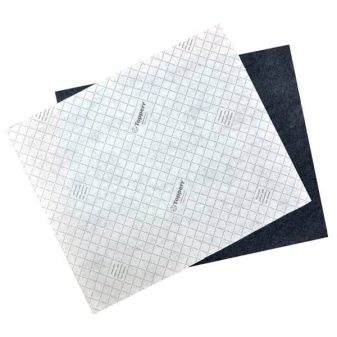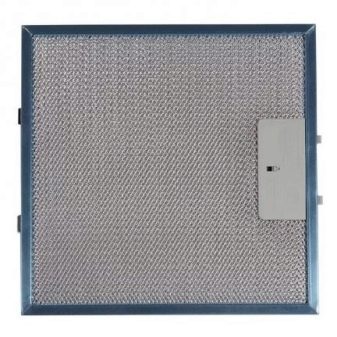Features of Fat Filters for Extraction

The hoods are designed to ensure the removal of polluted air from the kitchen. Most often, the drain goes to the street, especially when it comes to the use of units with only grease filters. What they are, how they differ and how they work - we will tell you in this article.

Views
There is a wide range of products on the modern market that are responsible for filtering fat particles. They have various sizes, types, and can be made from different materials. In addition, the effectiveness of these products is also uneven. However, with all this, fat filters are divided into 2 main types: disposable and reusable. Before purchasing items, you should carefully study their differences, pros and cons in order to make the right choice.
So, disposable filters. As the name suggests, these elements can be used only once, that is, after contamination, they must be disposed of and replaced with new ones. Dirty filters are unable to work effectively and cannot properly purify the air.
As for the reusable filters, their use is foreseen throughout the life of the cooker hood. However, in order for the filtration to take place efficiently, they should be cleaned at regular intervals, removing fatty deposits and combustion products. The material of manufacture can be metals or synthetic and organic fibers. This is the main difference between the products.


Elements made of non-woven fibers can be based on acrylic, non-woven and synthetic winterizer, in this case they can be called organic. To make the material more durable, it is usually glued. Such filters always have a lower price than their metal counterparts, and for the most part are disposable. The exception is acrylic products, however, although they can be cleaned and reused several times, they are still not reusable in the full sense of the word. This is because each cleaning partially destroys the element, preventing it from working equally effectively for a long time.
Some consumers tend to clean their filters in a more intense way, for which they simply try to wash them. This is not at all an option, since the structure of the fibers will definitely be violated, respectively, the element will not be able to fully perform the functions assigned to it, which will entail premature wear of the main equipment.


As for metal filters for kitchen hoods, they are always reusable, which means that they can be used for the same period of time as the unit itself. Elements can be made of foil, aluminum, as well as stainless or galvanized steel. If foil is the material of manufacture, it is stacked in several layers, in which special holes are made. This helps to fight pollution more effectively. Such products filter air very well, but they are not the most durable and cannot be used for too long.
Elements made of stainless steel or galvanized steel are exceptionally strong and durable, their service life in the overwhelming majority of cases is equal to the service life of the hood itself. They are also safe, not subject to corrosive processes and are very efficient in work. It should be borne in mind that such elements require competent maintenance and care, otherwise rust may appear on them.The main disadvantage of such products is their high price, therefore they are installed exclusively on expensive and high-quality models of hoods.
Aluminum filters, like steel ones, have a long service life, effectively purify the air, and are durable. For their greater durability, in some cases, anodizing of the elements is used, after which the oxidation process can be excluded.

However, such products, especially with the use of anodizing, are also not cheap.
Device and principle of operation
Any universal grease filter looks like a cassette. It has a sturdy frame as well as mesh sheets of material. It is these sheets that help filter the air and retain contamination. The angle of inclination of the meshes effectively traps dirt.
The main element of the filter is a mesh, either asymmetric or uniform. It is impossible to say with certainty which of them is better or worse, so the choice of a certain type should not be a priority when buying. For more reliable filtration, several layers of mesh can be laid in the frame at the same time, this will contribute to a change in the direction of air flows, which will serve to better purify the air, more effectively retain fat and combustion products. In some cases, one filter is divided into several cassettes, this is done for easier cleaning and installation of elements.

Modern hoods have two modes. The first of them is that the air is discharged outside or into the ventilation shaft, in other words, outside the premises. The second assumes circulation inside the kitchen, in this case, the air masses, after going through the cleaning process, return back.
The cleaning mode directly affects the functions performed by the filter. If the air is vented outside the kitchen, large particles of dirt do not enter the hood elements such as the engine and other components. If the recirculation mode is started, the priority goal is to directly clean the air in the room, but the structural elements are also reliably protected.
Moreover, the grease trap protects the carbon filter from contamination, with the help of which unpleasant odors and combustion products are eliminated from the room.

According to the above, the grease filter not only helps to clean the air, but also protects the hood and all its structural elements from plaque and contamination. This is necessary in order to exclude fatty deposits, which may appear inside after a few weeks of use. Accordingly, the load on the unit will increase, and during operation it may simply not be able to withstand it. And this can lead to serious breakdowns, the elimination of which will require significant financial costs.
During recirculation, the load on the grease element increases. If not properly cleaned, many problems can arise. This is because the air passing through the product is purified from both fats and impurities, as well as from excess odors. For this to be possible, an additional element is needed, which is not cheap and also needs protection.
Any contamination can quickly render the odor filter unusable and therefore needs protection.
This can lead to harm to health, as well as additional expensive repairs.

Installation and maintenance
The grease filter is located at the bottom of the hood, directly behind the charcoal filter, if one is included with the unit. Periodically, it requires cleaning, which can be done by hand. First of all, it is necessary to disconnect the hood from the network, after which you can remove the filter. To do this, you need to pull the latch on the lock towards you, carefully holding the grease trap itself.
All reusable grease filters are low maintenance. For the most part, they only need to remove dirt clogging the mesh. The elements are attached to special clips, with the help of which they are easy to install and remove.After that, they can be cleaned with a special brush in soapy water.
The easiest way is to prepare a soap solution using ordinary laundry soap, despite the lightness, the effect will be excellent.


You can also use any kind of cleaning agent, for example, those used for washing dishes. In any case, after the procedure, the filter must be washed with plenty of water. It should be noted that washing powder is not the best option for washing these elements, because they can easily scratch the metal. For aluminum, it is not recommended to use soda, acidic and alkaline compounds.
After washing is finished, be sure to dry the filter before installing it. This is best done at room temperature, out of direct sunlight. If the element is placed in the hood wet, corrosive processes can form on the metal over time.
With disposable filters, everything is much easier. It is necessary to monitor their contamination, after which the element simply changes to a new one.
When exactly to do this, they will show special signs that will appear on the surface after the cells are clogged with dirt.

Tips from the masters
How efficiently the cooker hood will work depends on whether the consumer cares for the filter correctly. It is not necessary to purchase an expensive model, cheaper counterparts, with proper maintenance, will cope with their task no worse. According to customer reviews, the belief that the price of the unit directly affects the quality of cleaning does not always correspond to reality.
As for the care of the elements, the masters advise using ordinary cleaning agents when washing.used to tidy up ovens. The composition is applied to the filter with a brush, left for half an hour, and then washed off under running water. To save time and if possible, it is appropriate to use a dishwasher.
It is not recommended to use baking soda when washing filters. Its effects can cause stains from contact with metal. Also, we must not forget that aluminum does not tolerate exposure to high temperatures, under their influence it can darken and oxidize. You should wash the grease filters yourself once a month; using a dishwasher, the procedure can be carried out 1 time in 2-3 months.

You can find out how to replace the grease filter mesh for the hood in the video below.













The comment was sent successfully.